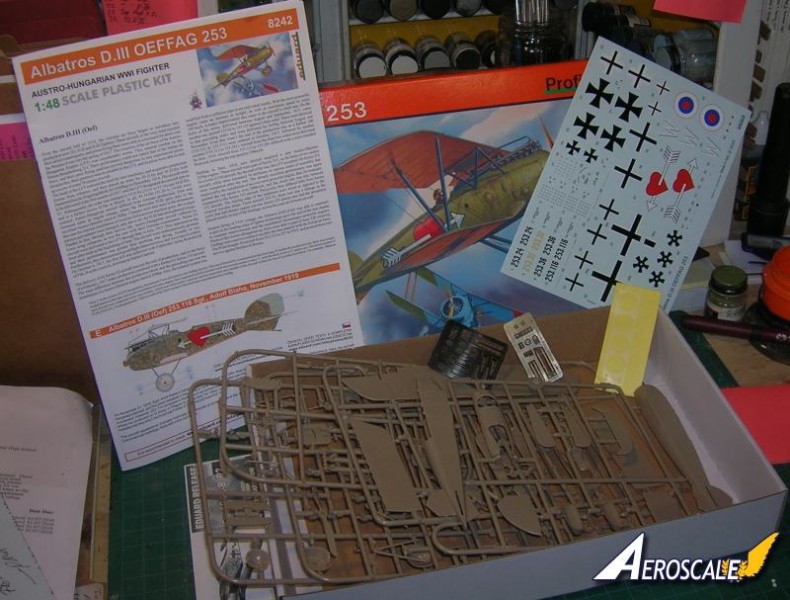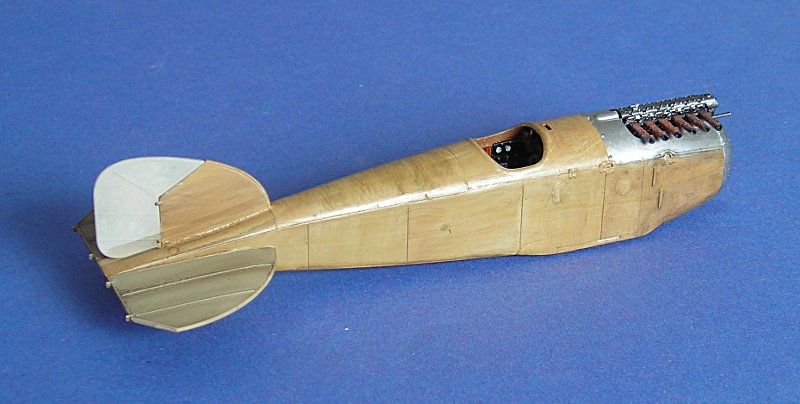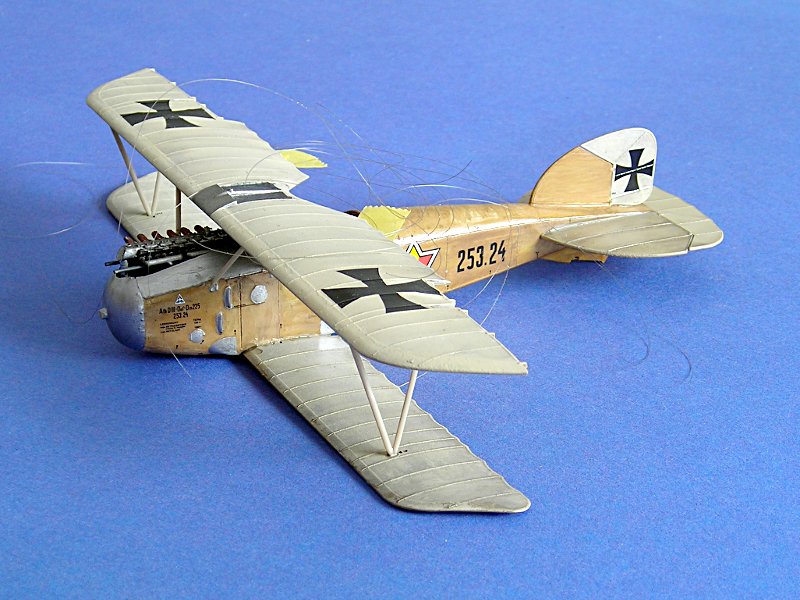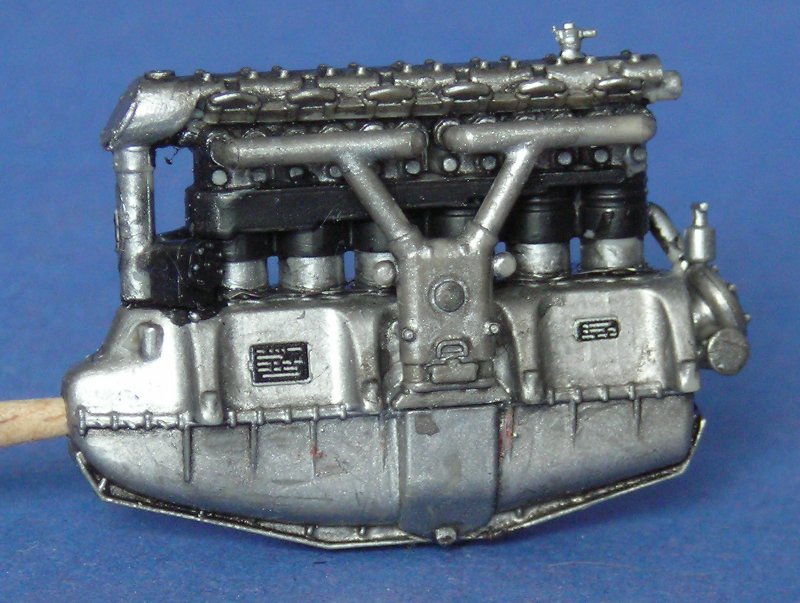REVIEW
Albatros D.III (Oeffag)
Colorado, United States
Joined: January 25, 2004
KitMaker: 11,669 posts
AeroScale: 11,011 posts
Posted: Sunday, August 01, 2010 - 09:50 PM UTC

Eduard's newest scale wonder is a 1:48 version of the Albatros D.III licence built Autro-Hungarian concern at Wiener-Neustadt. It was a finely improved version of the German original from Johannistahl Germany. Here we look at the first issue of what promises to be a great series.
Link to ItemIf you have comments or questions please post them here.
Thanks!
". . .The most important thing is to know why you build and then get the most that you can out of building." via D.D.
Alberta, Canada
Joined: January 19, 2008
KitMaker: 6,743 posts
AeroScale: 6,151 posts
Posted: Monday, August 02, 2010 - 04:33 PM UTC
Thank-you for the review Stephen . Excellent job and will be a great tool to have when building the kit .


#041
Kobenhavn, Denmark
Joined: July 20, 2006
KitMaker: 10,069 posts
AeroScale: 3,788 posts
Posted: Friday, August 06, 2010 - 04:04 AM UTC
Thanks for a good review, Stephen. The extra notes are real value adding.
Very attractive camouflage scheme for the "arrow and heart" machine. It seems to be multi colour camouflage painted in the instructions, but overall green on the box. Is that the case? it is a little difficult to see from the photos.
Thanks for your time and effort.
Campaign'oholic - 252+ campaigns completed
Colorado, United States
Joined: January 25, 2004
KitMaker: 11,669 posts
AeroScale: 11,011 posts
Posted: Monday, August 16, 2010 - 09:20 AM UTC
Here is Eduard's Newsletter for August. Part of the content is the second Eduard build of the Alb. D.III (Oeffag) kit and a specific write up on the Austr-Diamler 200hp motor.
Click here. ". . .The most important thing is to know why you build and then get the most that you can out of building." via D.D.
Germany
Joined: September 07, 2005
KitMaker: 5,609 posts
AeroScale: 5,231 posts
Posted: Thursday, September 09, 2010 - 03:28 AM UTC
Hello Stephen
a question: is this the hatch that is to be removed according to Koloman?

sorry for asking stupid questions ....
all the best
Steffen
DULCE ET DECORUM EST PRO HOBBY MORI
Västra Götaland, Sweden
Joined: February 19, 2010
KitMaker: 1,473 posts
AeroScale: 1,450 posts
Posted: Friday, September 10, 2010 - 01:54 AM UTC
Quoted Text
Hello Stephen
a question: is this the hatch that is to be removed according to Koloman?

sorry for asking stupid questions ....
all the best
Steffen
Hi Steffen,

– Yep, that's the hatch that should'nt be there. It should however, be on the other side on the fuselage.
I think Stephen will confirm this as well.
Best Regards
Mikael
_________________________________________________________
Just finished the Wingnut Wings Taube. On to the Junkers D.1
Germany
Joined: September 07, 2005
KitMaker: 5,609 posts
AeroScale: 5,231 posts
Posted: Friday, September 10, 2010 - 02:58 AM UTC
Thank you Mikael!
but sadly it is too late now....

all the best
Steffen
DULCE ET DECORUM EST PRO HOBBY MORI
Västra Götaland, Sweden
Joined: February 19, 2010
KitMaker: 1,473 posts
AeroScale: 1,450 posts
Posted: Friday, September 10, 2010 - 03:26 AM UTC
Ah – too bad... But great looking wood and linen going on there

Best Regards
Mikael
_________________________________________________________
Just finished the Wingnut Wings Taube. On to the Junkers D.1
Germany
Joined: September 07, 2005
KitMaker: 5,609 posts
AeroScale: 5,231 posts
Posted: Friday, September 10, 2010 - 03:38 AM UTC
Thanks Mikael!
Yes I am happy with the wood effect and thus I do not want to destroy it by sanding down the hatch. Still I need to retouch the rudder and I just made a mistake ... but I think I can cope with it (I glued on the wings before painting the metal parts on the forward fuselage)
BTW this shall rather be a fun project, as I really am no expert in spruce and linen things (though I like the look of that stuff

)
cheers
Steffen
DULCE ET DECORUM EST PRO HOBBY MORI
Colorado, United States
Joined: January 25, 2004
KitMaker: 11,669 posts
AeroScale: 11,011 posts
Posted: Friday, September 10, 2010 - 06:54 AM UTC
Yes that is the one that should not be on the original aircraft.
". . .The most important thing is to know why you build and then get the most that you can out of building." via D.D.
Germany
Joined: September 07, 2005
KitMaker: 5,609 posts
AeroScale: 5,231 posts
Posted: Friday, September 10, 2010 - 07:29 AM UTC
Thanks for the confirmation Stephen!
all the best
Steffen
DULCE ET DECORUM EST PRO HOBBY MORI
Colorado, United States
Joined: January 25, 2004
KitMaker: 11,669 posts
AeroScale: 11,011 posts
Posted: Thursday, September 16, 2010 - 08:32 AM UTC
Eduard Oct. 2010 newsletter;
8241 Albatros D.III Oeffag 153 1:48 ProfiPACK 34.95
". . .The most important thing is to know why you build and then get the most that you can out of building." via D.D.
Indiana, United States
Joined: May 14, 2007
KitMaker: 3,117 posts
AeroScale: 2,270 posts
Posted: Thursday, September 16, 2010 - 09:17 AM UTC
Has anybody else noticed Steffan has been hanging around our Mess Facility quite a bit lately? Is it possible he has abandoned the world of aircraft that fly well over 150 MPH for the laid back world of Spruce and Linen?
I think maybe all all the Messerschmitts and Focke Wulfs will dearly miss him if he becomes a true convert.

Your build is looking great Steffan.
"Treat 'em Rough", Current Builds--Wingnut Rumpler
I am frequently seen with blood shot eyes from staying up past my nap time to get the right colour scheme on my latest WWI model?
Germany
Joined: September 07, 2005
KitMaker: 5,609 posts
AeroScale: 5,231 posts
Posted: Thursday, September 16, 2010 - 07:21 PM UTC
Sorry to disappoint you Carl, but I gave up nada.
It is just that I lost the fun in my superdetailtonsofPE P-38 project and needed something different. Thus I picked two other projects. I keep them on low public profile as I do not know if i will finish them....

cheers
Steffen
DULCE ET DECORUM EST PRO HOBBY MORI
United States
Joined: February 13, 2008
KitMaker: 36 posts
AeroScale: 35 posts
Posted: Thursday, September 16, 2010 - 08:02 PM UTC
Very nice job Steffen!
Do you have any close up photos of the engine and your really nice woodgrain?
Would love to see them if you do!

Dave
Germany
Joined: September 07, 2005
KitMaker: 5,609 posts
AeroScale: 5,231 posts
Posted: Thursday, September 16, 2010 - 08:20 PM UTC
Cheers David
Well, I do not want to take over this thread. I just had a question .... so Stephen if you prefer that I keep my stuff out of this, just shoot me a PM
I do have two pix of the engine (remember this is OOB and really simple):


I did touch up the mistakes with the exhaust colour and the drilled out stacks got a black wash.
No close ups of the wood grain, because it is nothing spectacular in contrary it is just a mix of Vallejo New Wood and Tamiya Buff painted thin glazing over a grey Vallejo Primer. Then some washes with Klear + Tamiya Smoke + Clear yellow and Citadel Devlan Mud ...
all the best
Steffen
DULCE ET DECORUM EST PRO HOBBY MORI
Colorado, United States
Joined: January 25, 2004
KitMaker: 11,669 posts
AeroScale: 11,011 posts
Posted: Friday, September 17, 2010 - 04:33 AM UTC
Greetings Steffen.
Think a new detailed thread dedicated to your build would serve everyone well. That way you could post all of your progress.
". . .The most important thing is to know why you build and then get the most that you can out of building." via D.D.
Colorado, United States
Joined: January 25, 2004
KitMaker: 11,669 posts
AeroScale: 11,011 posts
Posted: Thursday, January 26, 2012 - 02:59 PM UTC
Greetings all,
One of our new editors "eseperic" has posted this on the KotS II proposed GB thread and I thought it might serve well here.
Quoted Text
Hi everybody,
The recent review of the Eduard’s Weekend Edition Fokker D.VII was my personal “wild-card” into the world of Early Aviation. Although I reviewed the X-resin’s PWS-A at some point earlier, my interest and knowledge of the Early Aviation Era is trifling. However, learning from the early aviation aficionados here on Aeroscale, I am tempted to expand my knowledge on the subject and sign up for this campaign.
As many of you know, my area of interest is WWII subjects, especially the Luftwaffe fighters. However, from a historical point of view, I am very much interested in all aviation subjects that are somehow related to my country, and especially to my hometown. Roaming through the Early Aviation Forum on Aeroscale, I’ve noticed some very interesting names that rang my bell, but none like the name of Oblt. Miroslav (Fridrih) Navratil. I am sure that many of you are familiar with the biography of this Austro-Hungarian flying ace, but I will repeat some of it here as a small tribute to my compatriot who fought “the other peoples wars”, as the Great War is often referred to in our historiography.

Quoted Text
Miroslav Navratil was born in my hometown (Sarajevo) on June 19, 1893. The Historical Museum of Bosnia and Herzegovina in Sarajevo, which was an appalling fact to me, holds no record of his earlier career, although his latter collaborationist biography during the WWII is exhaustive.
Upon successful completion of primary and secondary school in his hometown, Navratil attended Infantry Cadet School in Graz (Libenau). He served with the First Bosnian-Herzegovinian Infantry Regiment on the Serbian front, where he was wounded twice in 1914. His regiment saw action in the battlefields of Italy, Montenegro and Romania. While serving with the regiment, Navratil was promoted to Oberleutnant, and soon after that he was wounded again in December 1916.
Tired and at dismal with the infantry, he joined the K. und K. Luftfahrttruppe (LFT) the following month, and received training as observer at Wiener-Neustadt. In July 1917 he was initially posted to Flik 13 at Galicia, only to be transferred to Flik 11 in October of the same year. After pilot training in November 1917, Navratil scored one victory with Flik 41J before assuming command of Flik 3J on June 9, 1918. With the former unit he scored nine more victories by the end of the Great War, with two additional and unconfirmed victories.
After the WWI ended, Navratil briefly served with the Yugoslav Royal Airforce. He was soon promoted to the rank of lieutenant colonel for his exceptional achievements. However, Navratil had to face the accusations of high-ranking Serbian officers for being pro-German in the wake of the WWII, because he insisted on the acquisition of German aircraft for the weakening Yugoslav air-force. The April war finds him in Zagreb, where he worked as a part-time journalist and military analyst.
With the establishment of the Independent State of Croatia (NDH) in April 1941, he is set in charge of the nascent air force, but is soon appointed as a military attaché in Bucharest. He was promoted to the rank of colonel general in August 1943, and acted as Croatian Minister of War from September 2, 1943 to January 29, 1944. After his dissent and quarrels with Ante Pavelić, who was the head of the NDH, he was again sent to Romania as ambassador, and soon retired.
Navratil moves with his family to Vienna in November 1944, where he waits the end of WWII. He was soon captured by the Americans and imprisoned at military camps in Giolling and Gmunden, only to be handed over to the new Yugoslav communist regime in December 1946. He was accused of war crimes and executed on June 7, 1947.
With Navratil’s biography in mind, and with my policy not to comment extensively on historically established facts, I wanted to pay homage to this particular KoTS by building my first WWI subject – Albatros D.III (OEFFAG 235). Some of you may be aware of the fact that one of the marking options in the Eduard’s Profipack edition (kit #8248) enables you to depict the 235.116, which is the aircraft flown by Navratil in the Fall of 1918. It is my intention to build Navratil’s aircraft with his figure next to it; I will also have to find appropriate resin figure, and have it refurbished in order to represent his handsome face and posture.
Since this is going to be my first early aviation subject, I will have to extensively rely on your help and expertise. I am looking forward to this adventure!
All the best!
". . .The most important thing is to know why you build and then get the most that you can out of building." via D.D.
Colorado, United States
Joined: January 25, 2004
KitMaker: 11,669 posts
AeroScale: 11,011 posts
Posted: Thursday, January 26, 2012 - 03:04 PM UTC
Entoni Seperic's second post on the subject.
Quoted Text
Well, my friends, I did some research on the Navratil’s aircraft. Apparently, there were two… However, none of this would be possible without the historical research undertaken by Dalibor Feuereisl, whom I wanted to credit by rough translations of the material available on his site, which is dedicated to the history of this particular aircraft. The site is, unfortunately, in Czech, but I managed to roughly translate the points of interest for my fellow modelers.
Albatros D. III (OEF) 253.116, with engine nr. 23266, was manufactured in September 1918 and delivered to Flik 3J, where it became the second personal machine of Oblt. Navratil. The aircraft was decorated with the same personal signature as the previous 253.06, i.e. heart stabbed with an arrow. Oblt. Miroslav Navratil is credited with ten aerial victories, eight of which he made with the previous aircraft. Identical “personal” signature, however, makes it very difficult to distinguish between the two aircraft on the existing photographs from the period. Virtually identical serial numbers on the machines, which are partially covered by the signature, can be distinguished only by comparing the somewhat differing trailing edges of the both arrow endings, or by identifying the Mausers mounted on the upper wing of 253.06.

Quoted Text
Of particular interest is probably one of the last photos of 253.06 at the Flik 3J Airport in Gardolo from August 1918 (above). The aircraft on the photo, from left to right, are: 153.173, 153.225, 253.06, 153.227, and possibly 153.244. The Navratil’s aircraft – the third from the left – has his distinctive “personal” signature; however, of particular interest is a non-standard cross applied on the rudder. It is the exact machine in which Oblt. Navratil crashed during a training flight on the October 21, 1918 after an unsuccessful emergency landing due to the seat malfunction. The aircraft was completely destroyed, and Navratil was hospitalized with serious injuries. He didn’t return to the battlefield until the end of the war.
When the end of war was declared, Zgsf. Adolph Bláha, one of the Czechs serving with the Flik 3J, was at the airport in Innsbruck, where the unit was transferred early in November 1918. On November 21, 1918, Bláha decided to desert from the unit in Oblt. Navratil’s Albatros D.III (OEF) 253.116. Stfw. Béla Mayer, who deserted with Bláha, flew over in Albatros D. III (OEF) 253.114. Due to navigational error and bad weather, both flyers landed at Schlieren, near Zürich. The aircrafts and the pilots were photographed, and the machines were transferred to the Dübendorf airport on December 28, 1918. Bláha and Mayer were handed over to the military police in Buchs, with Bláha being released in March 1919.
The newly established Czechoslovak government has undertaken diplomatic activities aimed at releasing the pilots and the acquisition of their aircrafts. The key to negotiation was payment of a storage fee of 4.200 Swiss Francs for the machines, which was demanded by the Swiss. Bláha was sent from Prague to Zürich on October 3, 1919 with a lump sum of 1000 Francs to pay the expenses associated with the machines. Upon his arrival at Zürich, Bláha was photographed sitting on the port side of the aircraft wearing his new uniform; the aircraft was still carrying the Navratil’s personal marking with the Czechoslovakian roundels already applied on the lower wing, and the K. und K. markings were repainted. Worth noticing is the port wheel, which obviously came from an Aviatik Berg DI, series 238.
At noon of October 29, 1919 – and after a short demonstration of his acrobatic skills over Zürich, perhaps to honor the first anniversary of the Republic – Bláha took course to Czechoslovakia, and after the four-hour flight landed at his residence in Plzeň. He then flew the machine to the Prague Air Corps on November 1, 1919. The machine drew lot of attention, and many of the pilots desired to have it as their personal aircraft. However, Bláha persuaded them not to fly the aircraft without his personal approval. But only two days later, on the morning of the 3rd of November 1918, Bláha crashed and destroyed the aircraft during landing on the snow covered airfield. The Bláha escaped with only minor injuries. The aircraft was officially written-off on the 3rd of January 1920, with the engine (nr. 11538/23266) being modified and subsequently installed in a Fokker D. VII.
The second aircraft (253.114) remained in Zürich as compensation for the storage costs, and was put in the Swiss service only at the beginning of 1921 (Nr. 611). Although fully operational and in good state, it was finally written-off in 1923.
Some of you may be interested in the equipment installed on the 253.116. Well, according to the protocol made on the 29th of October 1919, which records the state of the airframe immediately before the Bláha’s flight to Plzeň, Albatros D.III (OEF) 253.116 had the Austro-Daimler engine (nr. 11538), Heidluck propeller (nr. 13.153.6428), Morel anemometer (nr. 64612), Petravic tachometer (nr. 3392), altimeter (nr. 18434), Bosch magneto (nr. 75640), Thöne u. Fiala horizontal and Wien vertical inclinometer (nr. 4847) [K. und K. aircraft had one speedometer and two inclinometers installed], Daimler oil-pressure gauge 0-3 Atm, petrol gauge 0-5m (Manometerfabrik Berlin SW 68), Socius mercury thermometer (50-120), and the two machine-gun barrels.
Seems like a good historical background for my intended build, wouldn’t you agree?
All the best!
". . .The most important thing is to know why you build and then get the most that you can out of building." via D.D.





































